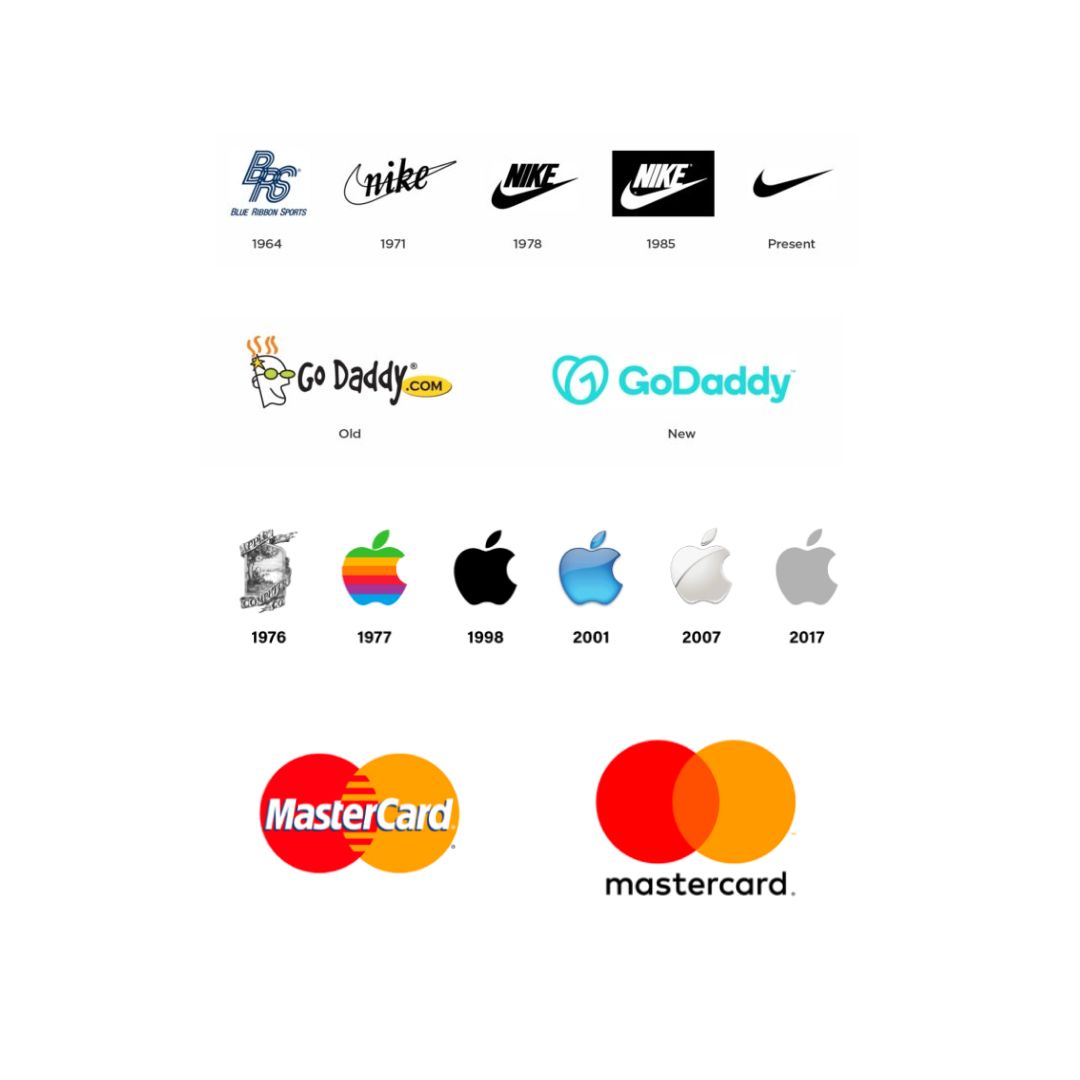Brand Refresh: How Often Should You Update Your Brand?
As a business owner, staying up to date with the latest trends and strategies is key in order to keep your brand relevant.

But when it comes to updating your branding – how often should you really be changing it? Updating your brand or executing a brand refresh too often can confuse customers, while if done too infrequently it may become old-fashioned. Striking the right balance of rebranding at regular intervals is essential for maintaining relevance, client loyalty, and generating sales. In this blog post, we will explore the importance of regularly updating your branding and discuss when is an appropriate time to consider adding fresh visuals or ideas into the mix.
The frequency at which you update your branding depends on several factors such as changes in your business strategy, target audience, industry trends, and the overall market.
Here are some things to consider when determining how often you should update your branding:
1. Changes in business strategy
If your business has undergone significant changes in its strategy, such as a shift in focus, expansion into new markets, or changes in products or services, it may be necessary to update your branding to reflect these changes.
Updating your branding is necessary when your business has undergone significant changes in its strategy, such as a shift in focus, expansion into new markets, or changes in products or services because your branding is a reflection of your business and its values. Your branding communicates who you are, what you stand for, and what you offer to your customers. If your business has undergone significant changes, it is likely that these changes will affect how your customers perceive your brand, and it may be necessary to update your branding to reflect these changes.
Here are a few reasons why updating your branding is important when your business strategy changes:
Consistency:
If your business has undergone significant changes, your branding may no longer be consistent with your new direction.
Updating your branding can help ensure that your brand is consistent with your new strategy and communicates a cohesive message to your customers.
Relevance:
Your branding needs to be relevant to your customers’ needs and preferences.
If your business has shifted focus or expanded into new markets, it is important that your branding reflects these changes and speaks to the needs and preferences of your new target audience.
Competitive advantage:
Updating your branding can help you differentiate yourself from competitors and establish a unique position in the market.
This can be especially important if your business has shifted focus or expanded into new markets, where you may be competing against new players.
Customer perception:
Your branding is a key factor in how your customers perceive your business. If your business has undergone significant changes, it is important that your branding reflects these changes to avoid confusion or mistrust among your customers.
Overall, updating your branding is necessary when your business has undergone significant changes in its strategy because it ensures consistency, relevance, competitive advantage, and positive customer perception of your brand.
2. Changes in the target audience
If your target audience has changed, such as moving from a B2B to a B2C model or targeting a different demographic, it may be necessary to update your branding to better resonate with your new target audience.
This is because your branding is a key factor in how your customers perceive your business, and different audiences may have different preferences and expectations.
Here are a few reasons why updating your branding is important when your target audience has changed:
- Messaging: Your branding communicates who you are and what you stand for to your target audience. If your target audience has changed, it may be necessary to update your messaging to better resonate with their needs and preferences. For example, if you are moving from a B2B to a B2C model, you may need to adjust your messaging to speak directly to individual consumers rather than business customers.
- Visual identity: Your visual identity, such as your logo and color palette, is an important part of your branding that can help you communicate your values and differentiate yourself from competitors. If your target audience has changed, it may be necessary to update your visual identity to better appeal to their preferences and resonate with their values.
- The tone of voice: Your tone of voice is an important aspect of your branding that can help you communicate your brand personality and build a connection with your target audience. If your target audience has changed, it may be necessary to adjust your tone of voice to better resonate with their communication style and preferences.
- Marketing channels: If you are targeting a different demographic or moving from a B2B to a B2C model, it may be necessary to adjust your marketing channels to reach your new target audience. Updating your branding can help you better align your marketing channels with your target audience and ensure that you are reaching them in the right places.
Updating your branding is important when your target audience has changed because it helps you communicate your values, differentiate yourself from competitors, and build a connection with your new target audience.
By adjusting your messaging, visual identity, tone of voice, and marketing channels, you can ensure that your branding resonates with your new target audience and helps you achieve your business goals.
3. Industry trends
If your industry is evolving rapidly, it may be necessary to update your branding to stay relevant and competitive, and it is important for businesses to adapt to stay competitive and relevant.
A key part of this adaptation is ensuring that your branding reflects the changes in the industry and meets the evolving needs and preferences of your target audience. Here are a few reasons why updating your branding can help you stay competitive in a rapidly evolving industry.
Reflecting industry trends:
As industry trends change, it is important for brands to stay up-to-date with the latest developments and adapt their branding accordingly. Updating your branding can help you demonstrate that your brand is aware of and responsive to the latest industry trends.
Attracting new customers:
As new players enter the market or consumer preferences shift, it can be important to update your branding to appeal to new customers. Updating your branding can help you stay relevant to a changing customer base and attract new customers who may not have previously considered your brand.
Reinforcing your position:
In a rapidly evolving industry, it can be difficult to maintain a strong position in the market. Updating your branding can help you reinforce your position by demonstrating your commitment to innovation and relevance.
Differentiating yourself:
As competition in the industry increases, it becomes increasingly important to differentiate your brand from competitors.
Update your branding to stand out from the crowd and differentiate your brand from competitors, making it more likely that customers will choose your brand over others.
Overall, updating your branding can help you stay relevant and competitive in a rapidly evolving industry by reflecting industry trends, attracting new customers, reinforcing your position, and differentiating yourself from competitors.

Rebrand fatigue
Rebrand fatigue is a term used to describe the negative impact that frequent and unnecessary rebranding can have on a brand’s reputation and consumer loyalty.
While rebranding can be a useful tool for keeping a brand fresh and relevant, excessive or poorly executed rebranding efforts can lead to confusion, alienation, and mistrust among customers.
Rebrand fatigue occurs when a brand updates its visual identity, messaging, or positioning too frequently, without clear justification or explanation. This can leave consumers feeling disconnected from the brand and unsure about its values, products, or services. Frequent rebranding can also make it difficult for customers to recognize and remember the brand, which can harm its overall effectiveness in the marketplace.
To avoid rebrand fatigue, brands should carefully consider the reasons for updating their branding and communicate those changes clearly to their audience.
It is important to ensure that the new brand identity is cohesive, consistent, and reflective of the brand’s core values and mission. Brands should also avoid making unnecessary changes to their visual identity or messaging, as this can cause confusion and frustration among customers.
In short, rebranding can be a powerful tool for refreshing a brand and staying relevant in a fast-changing market, but it should be done strategically and with careful consideration for the impact on customers.
Generally, it is recommended to update your branding every 5-10 years, or when significant changes in your business or industry occur.
However, this timeline can vary depending on your specific circumstances. It is always best to consult with branding professionals to determine the right frequency for your business.
What is brand refresh?
A brand refresh is a marketing strategy that involves updating and revitalizing an existing brand to better align it with the current market and customer needs.
A brand refresh is typically less drastic than a complete rebranding effort, and it aims to breathe new life into a brand by enhancing its visual identity, messaging, and overall brand experience.
A brand refresh typically involves updating one or more of the following elements of a brand:
- Visual Identity: A brand refresh may involve updating a brand’s visual identity, such as its logo, color palette, typography, and imagery. This can help the brand to look more modern and relevant to current trends and customer preferences.
- Messaging: A brand refresh may involve updating a brand’s messaging, such as its tagline, brand promise, and overall tone of voice. This can help the brand to communicate more clearly and effectively with its target audience and better resonate with their needs and preferences.
- Brand Experience: A brand refresh may involve updating a brand’s overall brand experience, such as its website design, packaging, and in-store experience. This can help the brand to create a more cohesive and memorable brand experience that helps it stand out from competitors.
- Product or Service Offerings: A brand refresh may also involve updating a brand’s product or service offerings to better align with the needs and preferences of its target audience. This can help the brand to remain competitive in the market and meet the changing needs of its customers.
A brand refresh is a way for a brand to stay relevant and competitive in the market by updating its visual identity, messaging, brand experience, and product or service offerings.
Conclusion
In summary, the frequency of your branding updates is something that requires consideration and thought.
Your business strategy, target audience, industry trends, and the overall market will all have an influence on when you should update your branding. Given the importance of staying current in today’s always-evolving digital world, it is worth taking a few months to review and analyze these factors to ensure your brand remains fresh and relevant.
Moreover, if you’re looking to build an effective brand presence, investing in redesigns or rebrands every couple of years may be necessary in order to stay competitive.
But knowing exactly when—and how—to make those changes can be difficult. The key is to carefully evaluate the situation before committing to any major branding decisions. So ask yourself: When was the last time your logo was updated? How often do you review your brand? Ultimately, how often do you update your branding?
Read more about branding:
Brand Anatomy – What Is It, And What Are Its Key Elements?
How To Choose A Brand Pattern For Your Branding
Brand Style Guide: How to Write One for Your Brand
Last Updated on 05/03/2025 by Victoria Silber









